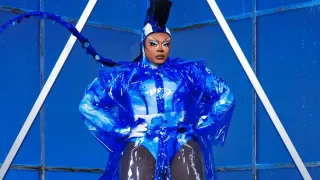April 23, 2015
Netflix Serves Up First Documentary Series: Chef's Table
Matthew Wexler READ TIME: 5 MIN.
Behind a set of shades hiding the dining room from the kitchen, chef Niki Nakayama wraps her fingers around a giant live scallop and gently pries open the shell. She takes a knife and trims out the sand-colored flesh inside. Later, she'll pair it with kiwi, dill and a beet and sorrel sauce with a ponzu base.
It's those unexpected, enticing combinations that have made Nakayama a standout in the culinary world. And later this month, she'll stand out for yet another reason. She's one of just six chefs to be profiled on Netflix's first homegrown documentary series, "Chef's Table," which features some of the most innovative chefs cooking today.
The show takes viewers inside Nakayama's Los Angeles restaurant, n/naka, where she prefers to work out of view. That's symptomatic of many years working in the world of sushi, where being a female chef brought unwanted attention. As one of only a handful of female Japanese chefs, she was seen as an oddity, even slighted by male patrons, including one who dismissed her work as "cute."
These days, the 40-year-old Los Angeles-born chef crafts intricate 13-course kaiseki meals, a Japanese tradition dating back to the 13th century that presents a conversing succession of raw heavy and light dishes, grilled, steamed and fried offerings with an emphasis on local ingredients.
Aside from her unusual pairings, she's also known for her imaginative platings and attention to detail: The restaurant keeps track of everything customers eat to make sure they aren't served the same meal twice.
"If you come back and experience that same menu, that experience is going to go down," Nakayama said. "We have to stay above that and keep them wondering."
Nakayama recently spoke with AP about kaiseki, the role Los Angeles plays in her cuisine, and stepping in front of the camera.
Discovering Kaiseki
AP: What was it like growing up as the daughter of Japanese immigrants working in the Los Angeles seafood industry?
Nakayama: I started working with them since the age of 12 and my feeling was, "I really don't like selling seafood." It smelled funny and it was so cold inside and there were all these big fish all over. It was more scary than appealing. But one of the great things having grown up in a family that did seafood is we had the opportunity to try so many kinds of seafood.
AP: How did kaiseki begin?
Nakayama: Kaiseki originated from the Buddhist monasteries. It was about creating food around the tea ceremony. Over time it evolved into two different kinds of kaiseki. Even the writing of it is different in Japanese. The vegan style is still done today, but there's a different version. It's representative of a formal banquet where people sit and gather and there's a lot of luxury, a lot of food that is very grand. You would say that's the complete opposite of the original kaiseki. But the one thing they maintained in both philosophies is appreciation of nature, of seasons. There's this underlying belief that we should protect the ingredient, preserve it's natural flavors as much as possible.
AP: What are you trying to express with any given plate?
Nakayama: We try to showcase the colors of the seasons. For summer there's a lot of green. For autumn, a lot more red and gold and brown. Winter is a lot of darker colors, more subdued. And springtime is bright, bright green. There's a new beginning. When you experience kaiseki, you're very attuned with what's happening all around you. That's a big thing about kaiseki. When you eat that meal, you automatically know, "This is spring. This is summer. Autumn. Winter."
AP: Is your take on kaiseki influenced by your upbringing?
Nakayama: Yes, definitely. I think when it's a menu that's created, it's very representative of personal tastes and experience. When we go to eat at a traditional Japanese restaurant, of course, we don't expect to eat pasta, but that is one of our more popular dishes here. It's just because I personally love pasta and I think it's wonderful to have the ability to put it on the menu. It's definitely reflective of the things that I eat and I feel is really a good representation of having this Asian and American culture at the same time.
AP: Do you think it has gotten easier to be a female sushi chef?
Nakayama: That's a difficult question. For me personally, I feel that I've been very fortunate in people's opinion and people's acceptance of n/naka. I feel like I've received a lot of positive feedback from people and it's not so much an issue anymore that I'm a female chef doing this Japanese cuisine that's traditionally male. I feel that people are very supportive of it and I've been very fortunate at this space. In terms of sushi, if I were to stand behind a sushi bar at this point, I don't really know what people would think. I'm not 100 percent sure just yet.
AP: You've been known to keep a low profile. What was it like being in front of the camera?
Nakayama: That was actually not as nerve wracking as I thought it would be. The director did an amazing job making all of us feel comfortable. And it seemed like such a wonderful opportunity to get what it is we're doing out there for people to understand better. I feel a little bit disappointed when people come here and they automatically assume they're at a sushi restaurant. Because what we are is not a sushi restaurant. It would be amazing for people to understand that with Japanese food, there's so much more than sushi.






